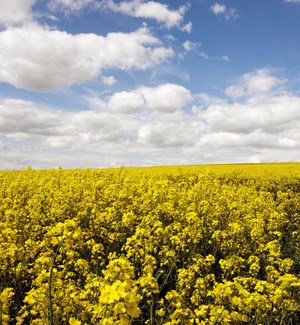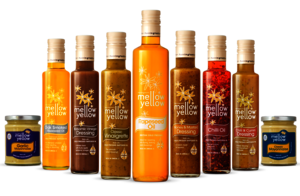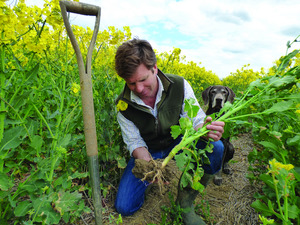Combined rotation, cover crops and companion cropping (UK)
Duncan Farrington is a 4th generation farmer at Bottom Farm. He grows arable combinable crops on approximately 730 acres (300 hectares) around the village of Hargrave, Northamptonshire, United Kingdom. In 2005, as a result of farm diversification, Bottom Farm became the UK’s first seed to bottle producer of cold pressed rape seed oil under the brand name Farrington’s Mellow Yellow. A broad rotation of winter and spring crops are produced including wheat, barley, rapeseed, and beans. Crops are grown with an eye to local customers as the farm is ideally located near to several millers and end users. Bottom Farm engages in several environmental measures, adopting modern farming technology whilst taking the environment into account, both of which are key to an Integrated Farm Management approach making it perfect as a LEAF (Linking Environment and Farming) Demonstration Farm and LEAF Marque certified farm.



Problem encountered
Farming practices at Bottom Farm revolve around creating healthy soils, integrated with high environmental and conservation measures. Production of cereals and oil seeds are important at Bottom Farm, however growing consistently the same rotation throughout the years increases weeds such as blackgrass in cereals, pest damage in the form of pigeons in oil seed rape as well as an increase in many diseases. It also takes a toll on soil nutrition. Duncan has been looking at ways to tackle these issues whilst still being concerned about the environment.
Solutions implemented
Duncan has been looking at ways to diversify his cropping rotation to help improve soil quality, control weed pressure, improve fertility, and manage pest and diseases. The main implementation was broadening the rotation on farm. Historically the rotation was: 50% First wheat → 5-10% 2nd wheat → 30% Oil seed rape → 10% beans with no cover or catch crops.
Now the rotation at Bottom farm is: 40-50% First wheat → 20% Oil seed rape → 15% Spring barley → 15% beans.
In between this rotation, for past few years Bottom Farm has been growing cover and catch crops. For example, before the spring barley, a cover mix of black oats, vetch and phacelia is grown. The winter wheat is now planted in mid to late October. Before this, a catch crop is grown. In 2019 this was Buckwheat as it is good at phosphate fixing and grows very quickly.
Taking out the 2nd wheat, introducing spring barley, and increasing production of legumes alongside cover and catch crops has helped widen the rotation.
Challenges encountered
Since 1998 Duncan has been looking at ways to diversify the cropping rotation at Bottom Farm and has looked at a variety of differing cropping systems. In his words it is “trial and error. I’ve learned an awful lot and gained great experiences. I still make mistakes, but I am learning from them and will make less mistakes in the future”.
The success of combining, catch, cover and companion crops at Bottom Farm in the rotation has proven to be sustainably and economically viable. The practice looks after the soil, creating a nutritionally healthy and vibrant soil which is leading the way to growing good crops. Duncan believes a broader crop rotation is the way forward for sustainable agriculture; it’s not a short term fix but an enjoyable journey.
Why was it successful?
Cover crops and catch crops are helping to broaden the rotation. Having completely different species in the mix is helping with weed control as well as complimenting the crop and soil nutrition. For example, buckwheat is good at hunting for phosphate, making it available for the following crop. Whereas legumes, such as vetches and beans, fix nitrogen making it available for the next crop. Duncan is also trialling companion cropping in his oil seed rape, by using vetch alongside to help control pigeon damage throughout the winter.
By broadening the rotation with a mix of different crops and species, another benefit is that they all have differing rooting systems. For example, phacelia is good for lateral roots whereas European oats or black oats have more fibrous, deeper root systems. All of this helps to break up the soil and give it structure, without having to disturb the soil too much through heavy cultivation work such as ploughing.
On the topic of cultivation, since 1998 Bottom Farm has adopted a minimum tillage system and is working increasingly towards a zero-tillage system. Together with cover and catch cropping, it is helping to reduce soil movement. This has helped control black grass as well as improve soil quality markedly on the Farm: soil organic matter has increased around 75% since 2002.
Duncan has found that diversifying his cropping rotation has been both environmentally and economically sustainable which is all part of Integrated Farm Management. Economic gains have been made by looking at the bigger picture from both machinery used and the saving on fuel to the different types of crops grown which is good for soil nutrition, weed and disease pressure, and reducing the use of artificial pesticides and fertiliser. Since adopting and combining these practices together cation exchange capacity in the soils at Bottom Farm is increasing year on year, which illustrates that the nutritional density of the soil is improving and becoming more wholesome and resilient, growing more nutritionally dense crops.
 tap and then scroll down to the Add to Home Screen command.
tap and then scroll down to the Add to Home Screen command.